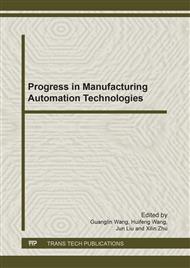p.107
p.112
p.117
p.122
p.129
p.134
p.140
p.144
p.149
Cutting Parameters Optimization of Turning Titanium Alloy Diaphragm Disk Based on Surface Topography Simulation
Abstract:
A model of micro surface topography interacted by the tool vibration is constructed according to working process characteristics and quality requirements of cutting titanium alloy diaphragm disk in high-speed; based on established micro surface topography model, an optimization methodology is designed by using genetic algorithm and then parameters optimization of titanium alloy diaphragm disk turning in high-speed and surface topography simulating system is developed. By the comparative analysis of the experiment and simulation result, it is easy to find that the simulation results have high consistency with the tested results of surface topography and it could meet the surface quality requirements by using optimized cutting parameters, and the established system is credible and practical.
Info:
Periodical:
Pages:
129-133
Citation:
Online since:
July 2011
Authors:
Keywords:
Price:
Сopyright:
© 2011 Trans Tech Publications Ltd. All Rights Reserved
Share:
Citation:


